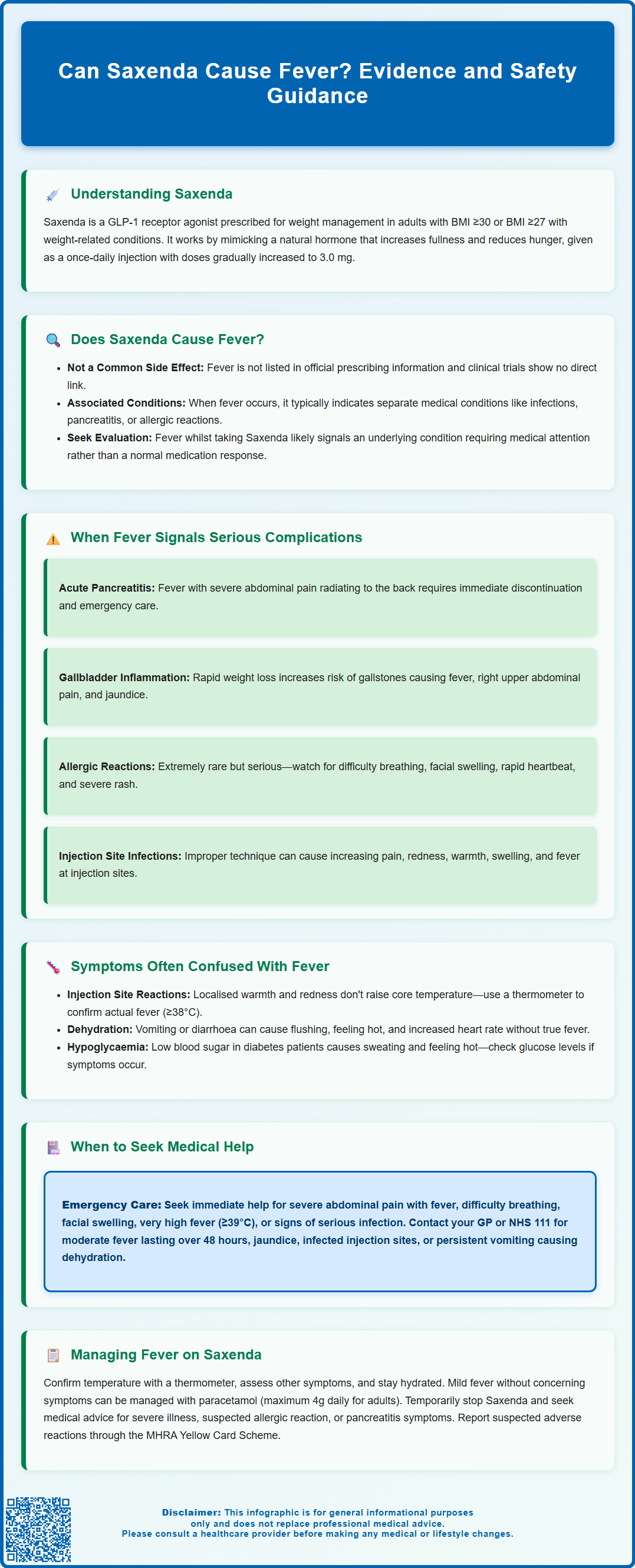Mounjaro®
Dual-agonist support that helps curb appetite, hunger, and cravings to drive substantial, sustained weight loss.
- ~22.5% average body weight loss
- Significant weight reduction
- Improves blood sugar levels
- Clinically proven weight loss

Saxenda (liraglutide 3.0 mg) is a GLP-1 receptor agonist licensed in the UK for weight management in adults with obesity or overweight with related health conditions. Whilst Saxenda has a well-documented side effect profile—predominantly gastrointestinal symptoms such as nausea and vomiting—many patients wonder whether fever can occur during treatment. Understanding whether Saxenda can cause fever, and when fever might signal a serious complication, is essential for safe medication use. This article examines the evidence surrounding fever and Saxenda, explores potential underlying causes, and provides guidance on when to seek medical attention.
Summary: Fever is not a commonly reported or expected side effect of Saxenda (liraglutide), but when it occurs, it may indicate serious complications requiring medical evaluation.
Saxenda (liraglutide 3.0 mg) is a prescription medicine licensed in the UK for weight management in adults with obesity (BMI ≥30 kg/m²) or overweight (BMI ≥27 kg/m²) with weight-related health conditions such as type 2 diabetes, hypertension, or dyslipidaemia. In some cases, it may also be prescribed for adolescents (12 to <18 years) with obesity. It belongs to a class of medications called glucagon-like peptide-1 (GLP-1) receptor agonists, which work by mimicking a naturally occurring hormone that regulates appetite and food intake.
The mechanism of action involves binding to GLP-1 receptors in the brain, particularly in areas that control appetite. This leads to increased feelings of fullness, reduced hunger, and consequently lower calorie intake. Saxenda is administered as a once-daily subcutaneous injection, typically in the abdomen, thigh, or upper arm. The dose is gradually increased over five weeks to minimise side effects, starting at 0.6 mg daily and reaching the maintenance dose of 3.0 mg daily.
Common side effects of Saxenda are predominantly gastrointestinal and occur most frequently during the initial dose escalation period. These include:
Nausea (affecting more than 1 in 10 people)
Vomiting and diarrhoea
Constipation
Abdominal pain or discomfort
Dyspepsia (indigestion)
Headache
Injection site reactions (redness, itching, or bruising)
Most gastrointestinal side effects tend to improve over time as the body adjusts to the medication. According to the MHRA-approved Summary of Product Characteristics, these effects are generally mild to moderate in severity. Patients are advised to start with smaller meals and avoid high-fat foods to help manage these symptoms.
Importantly, treatment should be discontinued if a patient has not lost at least 5% of their initial body weight after 12 weeks on the full 3.0 mg daily dose, as continued treatment is unlikely to be beneficial. Understanding the expected side effect profile is essential for distinguishing between typical medication responses and potentially serious adverse reactions that require medical attention.

Fever is not commonly reported as a side effect of Saxenda in the official prescribing information approved by the MHRA. The Summary of Product Characteristics for liraglutide 3.0 mg does not list pyrexia (fever) among the frequently observed adverse reactions. Clinical trials involving thousands of participants have not established a clear causal link between routine Saxenda use and the development of fever as an isolated symptom.
However, it is important to understand that fever is not an expected reaction to routine Saxenda use in the absence of other complications. When fever does occur in patients taking Saxenda, it is typically associated with specific medical conditions rather than being a direct drug effect.
In post-marketing surveillance and real-world use, isolated reports of fever in Saxenda users have occasionally been documented, but these cases are generally linked to:
Infections (unrelated to the medication)
Inflammatory complications such as pancreatitis or cholecystitis
Injection site infections (rare)
Allergic or hypersensitivity reactions (very rare)
The European Medicines Agency (EMA) and MHRA continue to monitor safety data for all GLP-1 receptor agonists, including Saxenda. Current evidence does not support fever as a typical or expected reaction to liraglutide therapy. If fever develops whilst taking Saxenda, it should be considered a potential indicator of an underlying condition that requires medical evaluation rather than a direct medication side effect. Patients experiencing unexplained fever should not assume it is a normal response to their weight management treatment and should seek appropriate medical advice to identify the underlying cause.
Suspected adverse reactions to Saxenda can be reported via the MHRA Yellow Card Scheme (yellowcard.mhra.gov.uk or the Yellow Card app).
Whilst fever is not a direct side effect of Saxenda, its presence may signal serious complications that require urgent medical attention. The most concerning conditions associated with GLP-1 receptor agonists that may present with fever include acute pancreatitis and cholecystitis (gallbladder inflammation).
Acute pancreatitis is a rare but serious adverse effect associated with Saxenda use. The Summary of Product Characteristics carries specific warnings about this risk. Pancreatitis typically presents with:
Severe, persistent abdominal pain (often radiating to the back)
Nausea and vomiting
Fever (in many cases)
Rapid pulse
Abdominal tenderness
If pancreatitis is suspected, Saxenda must be discontinued immediately and not restarted if pancreatitis is confirmed. Patients should seek emergency medical care if they experience severe abdominal pain that does not resolve, particularly if accompanied by fever.
Cholecystitis and cholelithiasis (gallstones) occur more frequently in people losing weight rapidly, regardless of the method. Saxenda may increase this risk. Symptoms include:
Right upper abdominal pain (especially after eating)
Fever and chills
Nausea
Jaundice (yellowing of skin or eyes)
Severe allergic reactions (anaphylaxis), though extremely rare, may present with symptoms such as difficulty breathing, swelling of the face or throat, rapid heartbeat, and severe rash. This constitutes a medical emergency requiring immediate treatment.
Injection site infections, whilst uncommon, can develop if proper injection technique is not followed. Signs include increasing pain, redness, warmth, swelling at the injection site, and fever. Any patient experiencing fever alongside severe abdominal pain, jaundice, signs of allergic reaction, or infected injection sites should contact their GP urgently or attend A&E depending on symptom severity. These situations require prompt investigation and may necessitate discontinuation of Saxenda.
Several side effects of Saxenda may produce symptoms that patients might mistake for fever or that occur alongside feelings of being unwell, potentially leading to confusion about whether a true fever is present.
Injection site reactions are common, affecting up to 1 in 10 people according to the Summary of Product Characteristics. These may cause localised warmth, redness, and discomfort at the injection site. Patients might interpret this localised warmth as fever, but it represents a local inflammatory response rather than systemic pyrexia. True fever involves an elevated core body temperature (typically ≥38°C), whereas injection site reactions produce only localised warmth without affecting overall body temperature.
Headache and fatigue are frequently reported side effects, particularly during the initial weeks of treatment. These symptoms, combined with general malaise, may create a sensation of being unwell similar to having a viral infection with fever. However, these symptoms can occur without any temperature elevation and typically improve as the body adjusts to the medication.
Dehydration resulting from gastrointestinal side effects (vomiting, diarrhoea) may cause symptoms including:
Dizziness and lightheadedness
Increased heart rate
Feeling hot or flushed
Weakness
These symptoms might be mistaken for fever, but they reflect fluid and electrolyte imbalance rather than true pyrexia. Maintaining adequate hydration is essential when experiencing gastrointestinal side effects.
Hypoglycaemia (low blood sugar), particularly in patients also taking diabetes medications such as insulin or sulfonylureas, may cause sweating, shakiness, rapid heartbeat, and feeling hot—symptoms that could be confused with fever. However, hypoglycaemia is accompanied by specific symptoms such as confusion, hunger, and trembling, and resolves quickly with glucose intake. People with diabetes should check their blood glucose levels if they experience these symptoms.
To distinguish between these symptoms and true fever, patients should measure their temperature with a thermometer rather than relying on subjective feelings. If uncertainty exists about whether symptoms represent normal side effects or something more serious, consulting a healthcare professional is advisable. Keeping a symptom diary can help identify patterns and facilitate discussions with your GP or prescribing clinician about whether symptoms are within the expected range for Saxenda therapy.
If you develop a fever whilst taking Saxenda, a systematic approach will help determine the appropriate course of action and whether medical attention is needed.
Immediate steps:
Confirm the fever by measuring your temperature with a reliable thermometer. A fever is generally defined as a temperature of 38°C or higher.
Assess accompanying symptoms carefully. Note any abdominal pain, nausea, vomiting, injection site changes, rash, difficulty breathing, or other concerning features.
Review recent events including potential exposure to infections, recent injections, and any new medications or foods.
Stay hydrated by drinking plenty of water, particularly if you have gastrointestinal symptoms.
When to seek urgent medical attention (contact 999 or attend A&E):
Severe, persistent abdominal pain with fever (possible pancreatitis)
Signs of allergic reaction: difficulty breathing, facial swelling, severe rash
High fever (≥39°C) with severe symptoms
Signs of severe infection: confusion, rapid breathing, chest pain
When to contact your GP or NHS 111 (same day or next available appointment):
Moderate fever (38–39°C) lasting more than 48 hours
Abdominal pain (especially right upper quadrant) with fever
Jaundice (yellowing of skin or eyes)
Injection site infection: increasing redness, warmth, swelling, or pus
Persistent vomiting or diarrhoea with fever leading to dehydration
Regarding Saxenda continuation:
You should temporarily withhold Saxenda and seek medical advice if you develop severe systemic illness, suspected severe allergic reaction, significant dehydration, or symptoms of pancreatitis. Your GP or prescribing clinician will advise whether to continue, temporarily suspend, or permanently discontinue treatment based on the underlying cause of your fever.
For mild fever without concerning features, it may be appropriate to manage symptoms at home with paracetamol (following dosing instructions, maximum 4g per day in adults) whilst monitoring your condition. Avoid NSAIDs like ibuprofen if you're dehydrated. If the fever persists beyond 48 hours or worsens, medical review is necessary.
Remember that fever in someone taking Saxenda should prompt investigation of the underlying cause rather than being attributed to the medication itself. Maintaining open communication with your healthcare team ensures safe and effective weight management whilst promptly addressing any complications that may arise.
If you suspect an adverse reaction to Saxenda, report it via the MHRA Yellow Card Scheme (yellowcard.mhra.gov.uk or the Yellow Card app).
No, fever is not listed as a common side effect in the MHRA-approved prescribing information for Saxenda. Clinical trials have not established a clear link between routine Saxenda use and fever as an isolated symptom.
Fever in Saxenda users may indicate serious complications such as acute pancreatitis, cholecystitis (gallbladder inflammation), severe allergic reactions, or injection site infections. These conditions require prompt medical evaluation.
Seek emergency care (999 or A&E) if fever occurs with severe abdominal pain, difficulty breathing, facial swelling, or high fever (≥39°C) with severe symptoms. Contact your GP or NHS 111 for moderate fever lasting more than 48 hours, abdominal pain, jaundice, or signs of injection site infection.
The health-related content published on this site is based on credible scientific sources and is periodically reviewed to ensure accuracy and relevance. Although we aim to reflect the most current medical knowledge, the material is meant for general education and awareness only.
The information on this site is not a substitute for professional medical advice. For any health concerns, please speak with a qualified medical professional. By using this information, you acknowledge responsibility for any decisions made and understand we are not liable for any consequences that may result.
Lorem ipsum dolor sit amet, consectetur adipiscing elit, sed do eiusmod tempor incididunt ut labore et dolore magna aliqua. Ut enim ad minim veniam, quis nostrud exercitation ullamco laboris nisi ut aliquip ex ea commodo consequat. Duis aute irure dolor in reprehenderit in voluptate velit esse cillum dolore eu fugiat nulla pariatur.
Block quote
Ordered list
Unordered list
Bold text
Emphasis
Superscript
Subscript